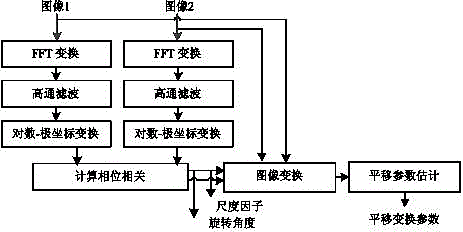Edge significance-based EFMT multi-sensor image registration method and system
A technology of edge images and heterogenous images, applied in the image field, can solve the problems of reduced correlation peak significance, mismatch, large registration error, etc.
- Summary
- Abstract
- Description
- Claims
- Application Information
AI Technical Summary
Problems solved by technology
Method used
Image
Examples
Embodiment 1
[0041] Such as figure 1 Shown is a schematic flow chart of the traditional FMT registration algorithm in the prior art. This method is an image registration method based on Fourier-Mellin transform (abbreviated as FMT algorithm) proposed by Chen et al. in 1994. It calculates two images Calculate the relative translation of the peak positions corresponding to the inverse Fourier transform of the cross power spectrum, and use the rotation and scale characteristics of the Fourier transform in the Log-polar space by performing logarithmic-polar coordinate (Log-polar) transformation on the image amplitude spectrum Find the rotation angle and scaling factor between images. Through a large number of experiments on remote sensing images, medical images, target recognition and tracking and other applications, Reddy et al. have proved that this method has the advantages of high precision and fast speed, but it is also effective for changes in illumination, different image content, occlu...
Embodiment 2
[0050] Such as image 3 Shown is a flow chart of another preferred embodiment of the EFMT heterogeneous image registration method based on edge saliency according to the present invention. It includes in turn: extracting the edge of the reference image R and the image S to be registered to obtain a binary edge image; transforming the edge image into the Log-polar domain to obtain LPr and LPs; performing cross-power spectrum calculation on LPr and LPs; calculating the Rotation angle and scale factor; perform inverse transformation on the image to be registered to obtain the righting image; perform phase correlation calculation based on the reference edge image and the righting edge image to obtain the translation amount; perform translation transformation on the rotated righting image according to the translation amount to obtain the registered image.
[0051] Specifically, step 1. Extract edges from the reference image R and the image to be registered S to obtain a binary edg...
Embodiment 3
[0078] This embodiment provides a heterogeneous image registration system, the system includes the following modules:
[0079] The edge extraction module is used to extract the edge image of the reference image and the image to be registered and the edge image of the transformed image;
[0080] A calculation module, for transforming the edge image into the logarithmic-polar coordinate domain, and calculating the phase correlation of the logarithmic-polar coordinate domain, obtaining the rotation angle and scale factor of the image and calculating the translation parameters of the image;
[0081] An image transformation module, the image transformation module performs image transformation on the image to be registered according to the rotation angle and scale factor, and performs translation transformation on the righting image according to a translation parameter.
[0082] Wherein, the edge extraction module further includes a time-domain edge detection module, and the edge im...
PUM
 Login to View More
Login to View More Abstract
Description
Claims
Application Information
 Login to View More
Login to View More - R&D
- Intellectual Property
- Life Sciences
- Materials
- Tech Scout
- Unparalleled Data Quality
- Higher Quality Content
- 60% Fewer Hallucinations
Browse by: Latest US Patents, China's latest patents, Technical Efficacy Thesaurus, Application Domain, Technology Topic, Popular Technical Reports.
© 2025 PatSnap. All rights reserved.Legal|Privacy policy|Modern Slavery Act Transparency Statement|Sitemap|About US| Contact US: help@patsnap.com



